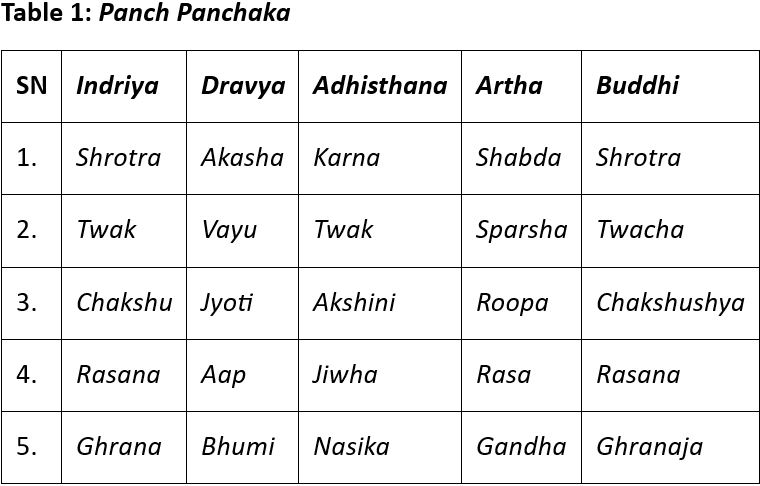A conceptual study of Buddhi w.s.r. to Intelligence
DOI:
https://doi.org/10.21760/jaims.10.6.26Keywords:
Ayurveda, Buddhi, Panchendriya BuddhiAbstract
The concept of Buddhi has a broad meaning in Ayurveda. It is genuinely regarded as the pinnacle of knowledge. First, Indriyas correctly perceive knowledge; then, Mana processes it; and last, after Manovyapara, the Buddhi is created. Creating complex scenarios and distributing these concepts, Among the various cognitive capacities that set humans apart from other living things are full-fledged language proficiency, as well as reasoning and planning ability. Buddhi (intellect) is one of the cognitive and perceptual instruments employed by Ayurveda to determine the exact characteristics of an object. When the Indriyas (cognitive organs) and Manas (mind) view the same item, perception takes place. The mind then analyses and transmits the information to the Buddhi, resulting in knowledge. Bhagvad Gita explains some of the Buddhi Gunas. Different intellectual functions can be associated with it. Mano Buddhi and Panchendriya Buddhi are the two varieties of Buddhi, based on differences in sensory perception. Since their activities are similar, the Panchendriya Buddhi is anatomically classified as having distinct sensory cortices and their associated cortices. A functional correlation between the process of cognition and the Buddhi’s considered Mano Buddhi can be found in their physiological makeup.
Downloads
References
Sharma RK, Dash B. Charaka Samhita. Varanasi: Chaukhamba Publications; 2015. Vol. 2, Sharir Sthana 1/22–23. p.316.
Shastri A. Sushruta Samhita. 12th ed. Varanasi: Chaukhambha Prakashan; 1997. Sutra Sthana Chapter 3, Shloka 28.
Sharma RK, Dash B. Caraka Samhita. Reprint ed. Varanasi: Chaukhamba Sanskrit Series Office; 2009. Vol. 2, Sharir Sthana 1/22–23. p.316.
Sharma RK, Dash B. Caraka Samhita. Shukla V, editor. 1st ed. Varanasi: Chaukhamba Sanskrit Sansthan; 2002. Vol. 1. p.678.
Ashigha S, Puranik P, Kavya. A conceptual study on Buddhi, Dhee, Dhriti, Smriti, Smritikaaranas and Medha in comparison to Jean Piaget’s cognitive development factors. Int J Ayurveda Pharma Res. 2023;11(Suppl 1):66–9. https://doi.org/10.47070/ijapr.v11iSuppl1.2681
Deva RR. Shabdkalpadrum. Part 3. Varanasi: Chaukhambha Prakashan; 1961. p.249.
Tripathi B. Charaka Samhita. 5th ed. Varanasi: Chaukhambha Prakashan; 1998. Sharir Sthana Chapter 1, Shloka 98.
Tripathi B. Charaka Samhita. 5th ed. Varanasi: Chaukhambha Prakashan; 1998. Sharir Sthana Chapter 1, Shloka 98.
Tripathi B. Charaka Samhita. 5th ed. Varanasi: Chaukhambha Prakashan; 1998. Sharir Sthana Chapter 1, Shloka 99.
Dwivedi L, editor. Charaka Samhita (Chakrapani Tika). Varanasi: Chaukhambha Prakashan; 2017. Sharir Sthana Chapter 1, Shloka 144.
Tripathi B. Charaka Samhita. 5th ed. Varanasi: Chaukhambha Prakashan; 1998. Sharir Sthana Chapter 1, Shloka 100.
Acharya JT, editor. Sushruta Samhita with Dalhan Tika. Varanasi: Chaukhambha Prakashan; Sharir Sthana Chapter 1, Shloka 23.
Tripathi B. Charaka Samhita. 5th ed. Varanasi: Chaukhambha Prakashan; 1998. Viman Sthana Chapter 4, Shloka 8.
Tripathi B. Charaka Samhita. 5th ed. Varanasi: Chaukhambha Prakashan; 1998. Sharir Sthana Chapter 1, Shloka 149.
Amarasimha. Amarkosh. With Ramasrami. 4th ed. Varanasi: Chaukhambha Prakashan; 2001. Pratham Khand, Chapter 5.
Shastri VD. Bhavaprakasha Nighantu. Delhi: Motilal Banarsidass; 1997. p.783.
Sharma RK, Dash B. Charaka Samhita. Varanasi: Chaukhamba Publications; 2015. Vol. 1, Sutra Sthana 8/12. p.167.
Acharya VJ, editor. Charaka Samhita. Elaborated by Charaka and Dridhabala, Commentary by Chakrapani. Varanasi: Chaukhamba Surbharati Prakashan; 2008. Sutra Sthana 8/3, 12. p.55–6.
Sastri PK, Chaturvedi G. Charaka Samhita. Varanasi: Chaukhambha Bharti Academy; 2023. Sutra Sthana Chapter 1, Shloka 28.
Sastri PK, Chaturvedi G. Charaka Samhita. Varanasi: Chaukhambha Bharti Academy; 2016. Sutra Sthana Chapter 1, Shloka 48.
Sastri PK, Chaturvedi G. Charaka Samhita. Varanasi: Chaukhambha Bharti Academy; 2016. Sharir Sthana Chapter 1, Shloka 23.
Hall JE, Guyton AC. Textbook of Medical Physiology. Philadelphia, PA: Saunders/Elsevier; 2011.
Devi G, Prashanth K, Shivprasad C. Improvement of Medha – An imperative need of the era. IAMJ. 2013;1(4):1–6.
Sharma PV. Susruta Samhita. English translation with Dalhana’s commentary and critical notes. Varanasi: Chaukambha Visvabharati; 2010. Vol. 2, Chikitsa Sthana Chapter 28, Verses 27–28. p.537.
Vidyanath R. Illustrated Caraka Samhita. English translation with Chakrapani commentary. Varanasi: Chaukhambha Prakashak; 2022. Sharir Sthana Chapter 1, Verse 98. p.509–10.
Jadavaji T, editor. Sushruta Samhita with Nibandhasangraha Commentary by Dalhana. Reprint ed. Varanasi: Chaukhambha Orientalia; 2013. Sharir Sthana Chapter 1, Verse 18. p.343.
Vidyanath R. Illustrated Caraka Samhita. Varanasi: Chaukhambha Prakashak; 2022. Sharir Sthana Chapter 1, Verse 100. p.510.
Vidyanath R. Illustrated Caraka Samhita. Varanasi: Chaukhambha Prakashak; 2022. Sharir Sthana Chapter 1, Verse 149. p.528.
Japang I, Rathi RB, Verma J, Dwivedi P. A literary review on Buddhi (IQ) and Smriti (Memory) – An Ayurveda approach. Int J Ayurvedic Med. 2022;13(3):667–72.
Surendran NS, Jadhav L, Shivprasad C. The psychological and physical dimensions to Smriti. Int Ayurvedic Med J. 2013;3(May–June). ISSN:2320-5091.
Vagbhata. Ashtanga Hridaya. With Sarvangasundhara commentary of Arunadutta and Ayurvedarasayana of Hemadri. Varanasi: Chaukhambha Subharati Prakashan; 2018. Sutra Sthana Chapter 5, Verse 37. p.125.
Sunagar MB, Kulkarni P, Sunagar SB. The concept of Manas in Ayurveda. WJPLS. 2021;7(12):31–3. ISSN 2454-2229.
Acharya YT. Commentary on Tarka Sangraha. 2nd ed. Varanasi: Chaukhambha Orientalia; 2017. Chapter 1, Verse 7.















